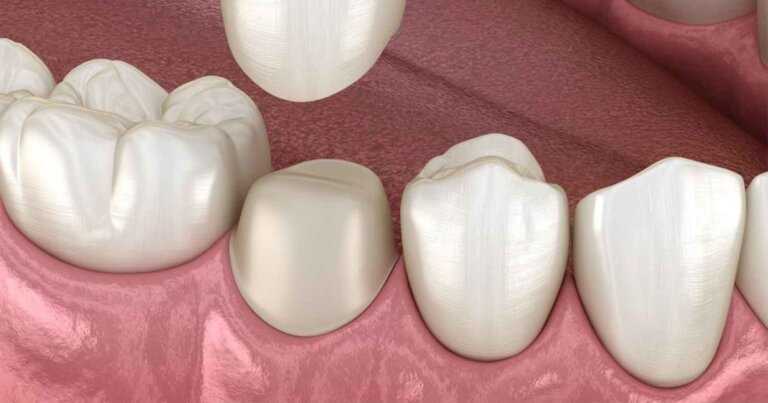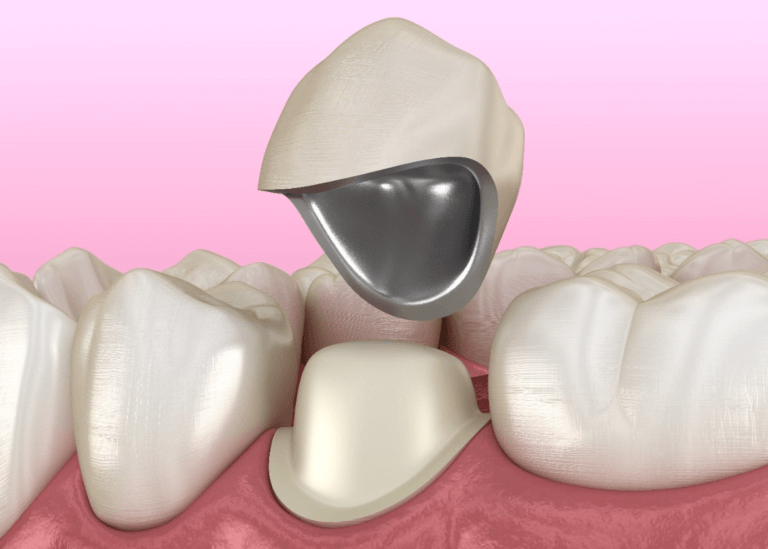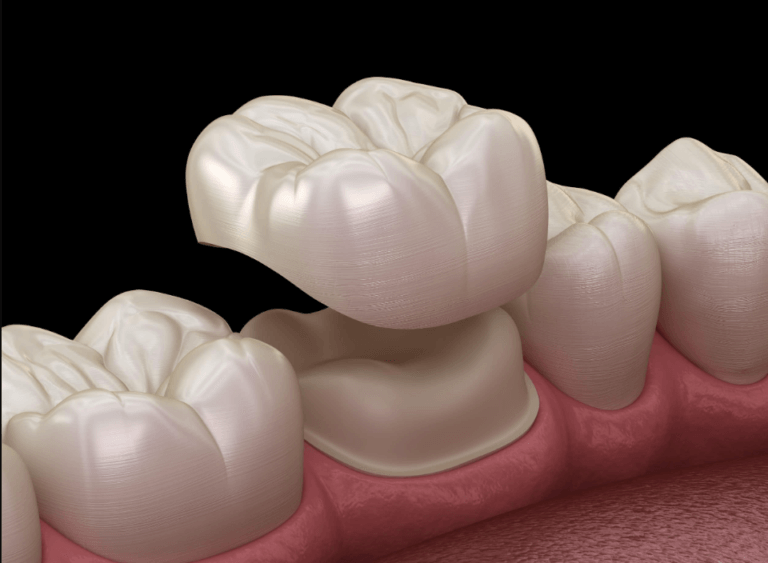Loose or Fallen Out Dental Crown

A Dental Crown provides essential strength and support to a weakened or damaged tooth. However, like any dental restoration, crowns can sometimes fall off or become loose. This can happen for a variety of reasons, and while it may be alarming, it’s not uncommon. With the right care and prompt treatment, a fallen or loose dental crown can be re-cemented back on by your dentist.
Before you schedule a visit at our Toronto dental clinic, there are some things that you should know as a patient:
- Common Causes For Dental Crowns Falling Off
- Signs and Symptoms of a Loose or Fallen Out Dental Crown
- Treatment Options For A Fallen Out Dental Crown
- Cost of Recementation for Dental Crowns
- Managing A Fallen Out Dental Crown Until You Can See The Dentist
- Frequently Asked Questions About Loose or Fallen Out Dental Crowns
Read more below to learn things you can do to manage the problem until you are seen by a dentist, or contact us for more information.
Common Causes For Dental Crowns Falling Off
A dental crown may fall off or loosen for several reasons. Understanding the cause is crucial for determining the best course of action:
- Dental Trauma: A sudden impact, like biting down too hard on something tough or experiencing an injury, can loosen or dislodge a dental crown.
- Tooth Decay: If a cavity develops under the crown, the decay can weaken the bond between the tooth and crown, leading to a loose or fallen crown.
- Weakened Dental Cement: Over time, the cement holding the crown in place can wear down or become brittle, especially with heavy wear or poor oral hygiene.
- Poor Fit or Damage: If the crown doesn’t fit properly or gets damaged (e.g., cracks or chips), it may not stay in place as it should.
A qualified dentist will assess the situation to determine why your dental crown unbonded and the best method of repairing it. If you have further questions about A Loose or Fallen Out Dental Crown, please contact us.

Signs and Symptoms of a Loose or Fallen Out Dental Crown
If your dental crown is loose or has fallen out, there are a few key signs to watch for:
- Movement or Shifting: A loose crown may wiggle or shift when touched with your tongue or fingers.
- Tooth Sensitivity: Exposed teeth may become sensitive to hot, cold, or pressure when chewing.
- Pain or Discomfort: Pain or swelling around the gum line could indicate underlying issues like decay or infection.
- Visible Gaps: A gap between the crown and the tooth can be a sign that the crown is loosening.
- Bad Taste or Odor: Foul taste or odor may result from trapped bacteria or food particles.
- Crown Falls Out: If the crown completely detaches, keep it safe and contact your dentist immediately.
If you notice any of these symptoms, it’s essential to see your dentist as soon as possible to avoid further damage. If you have further questions about A Loose or Fallen Out Dental Crown, please contact us.
Treatment Options For A Fallen Out Dental Crown
If your dental crown has come loose, there are several ways to address it. A dentist will recommend the best solution based on your specific situation:
- Recementing the Crown: In many cases, a dentist can clean and reapply dental cement to reattach the crown securely.
- Creating a New Crown: If the existing crown is damaged or worn, a replacement may be necessary.
- Root Canal Therapy: If decay has compromised the tooth under the crown, a root canal might be required before placing a new crown.
- Extraction and Replacement: In severe cases where the tooth or crown cannot be saved, extraction may be needed, followed by options like a dental implant or bridge.
Consulting with a dentist will help you choose the most appropriate solution based on the condition of your tooth and crown. If you have further questions about treatment options for a Fallen Out Dental Crown, please contact us.

Cost of Recementation for Inlays/Onlays/Crowns/Veneers
The cost of a recementing an Inlay, Onlay, Crown or Veneer starts at $221 and up, depending on the amount of time it takes the dentist to perform this procedure. Normally, it takes 30 minutes, and would cost $221 for one. The codes relevant to dental crowns in the Ontario Dental Association’s Suggested Fee Guide appear as follows:
Recementation/Rebonding, Inlays/Onlays/Crowns/Veneers/Posts/Natural Tooth Gragments (single units only)
- 29102 – Two Unit of Time (30 minutes): $221
- 29103 – Three Unit of Time (45 minutes): $316
- 29104 – Four Unit of Time (60 minutes): $412
The recementation of single unit dental prostheses is usually considered a basic restorative procedure covered by your dental insurance. Be sure to find out from your dental insurance plan provider how much you are eligible for before going ahead with dental treatment. Your dentist can help you submit an predetermination to your dental insurance. Our fees are consistent with the ODA Fee Guide.
Managing A Fallen Out Dental Crown Until You Can See The Dentist
If your crown falls out and you can’t see a dentist right away, here’s how to manage it temporarily:
- Store the Crown Safely: Place the crown in a clean container or bag and bring it with you to your dental appointment.
- Maintain Oral Hygiene: Brush gently around the exposed tooth and rinse with warm salt water to minimize bacteria and reduce the risk of infection.
- Avoid Hard or Sticky Foods: Stick to soft foods and avoid chewing on the affected side to prevent pain and protect the tooth.
- Use Temporary Dental Cement: Temporary dental cement can be bought at most pharmacies to hold the crown in place temporarily until you see a dentist.
- Use Over-the-Counter Pain Relief: If you experience pain, over-the-counter medications like ibuprofen or acetaminophen can help. Follow dosage instructions, and consult your dentist for advice if needed.
Remember, these are only temporary solutions. It’s essential to visit a dentist as soon as possible for proper care. If you have further questions about a Fallen Out Dental Crown, please contact us.
Frequently Asked Questions About Loose or Fallen Out Dental Crowns
- Can I eat with a loose or missing dental crown?
Yes, you can eat, but be cautious. Avoid chewing on the side of the mouth with the loose crown and steer clear of very hot or cold foods that could irritate the exposed tooth.
- Why does my tooth underneath the crown look black?
A black or discolored tooth under a crown may indicate tooth decay or damage. If you notice this, it’s essential to see your dentist for evaluation and possible treatment.
- Can I use superglue to reattach my crown?
No. Never use superglue or other adhesives to try to fix a loose crown yourself. Only your dentist should re-cement the crown using dental-specific adhesives.
- How long will my dental crown last?
With proper care, dental crowns can last between 10 and 15 years. However, factors such as oral hygiene, eating habits, and the material of the crown can impact its lifespan.
If you have more questions about loose dental crowns or need assistance with a fallen-out crown, contact us at Atlas Dental today. Our experienced team in Toronto is here to help you maintain a healthy, confident smile.

